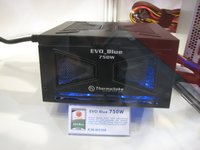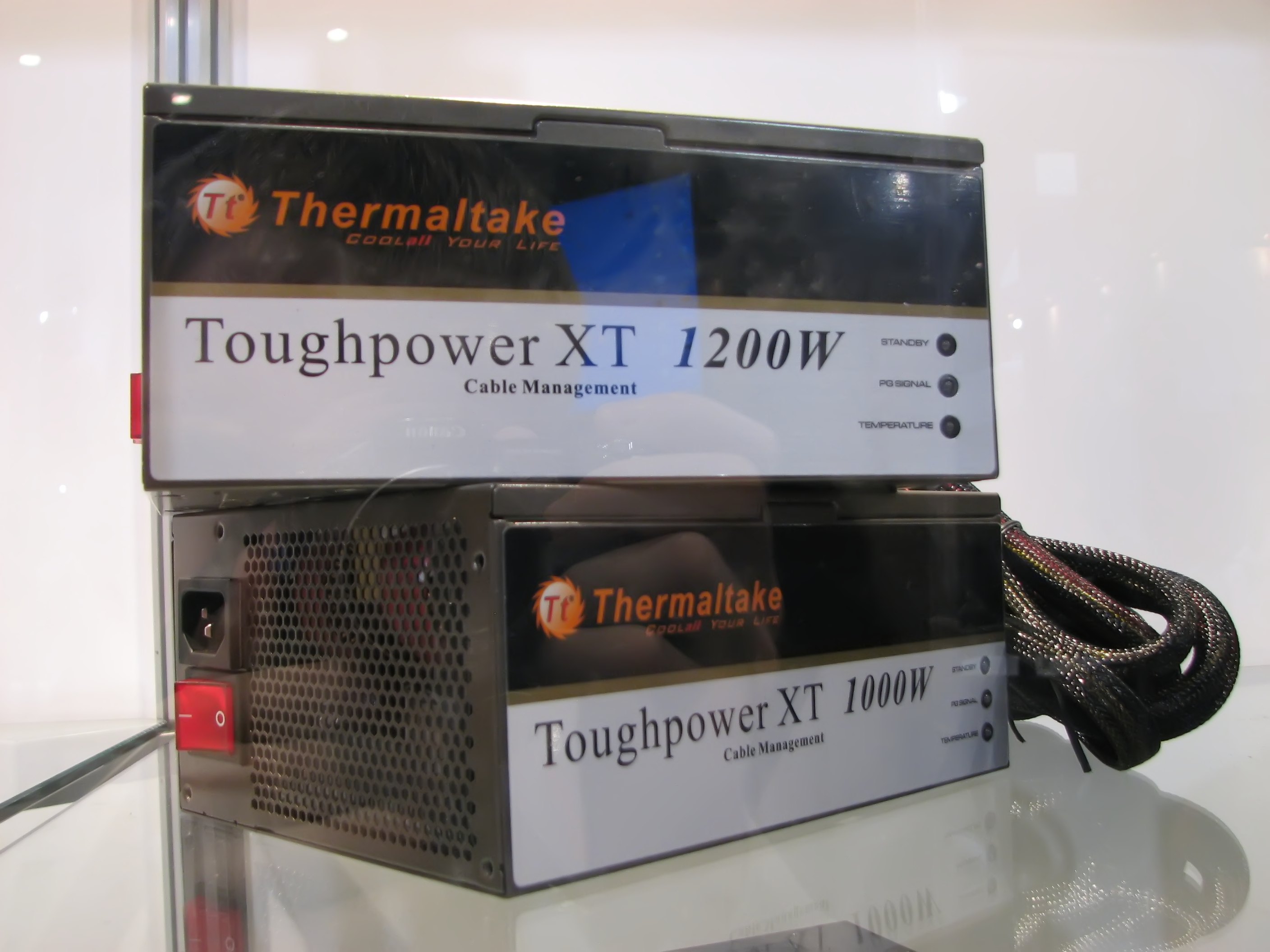Upcoming Performance Thermaltake PSUs
Thermaltake was showcasing its upcoming Toughpower XT series of power supplies at CES 2009, along with its new 750-watt EVO_Blue power supply.
The new Toughpower XT series will be offered in 650-watt, 750-watt, 850-watt, 1000-watt and 1200-watt variants, with additional variations offering cable management abilities. The Toughpower XT series features S.F.C quiet technology, a FanDelayCool function and three indicator lights, which indicate standby, PG signal and temperature status of the power supply.
The FanDelayCool feature is a cooling function that can be enabled to allow the cooling fans in the PSU to continue to run after the system has been shutdown, at an interval of 15 or 30 seconds. It would seem that this feature will help to increase the lifespan of the power supply. The S.F.C quiet technology controls the fan so that it always spins at the optimal speed, reducing any unneccessary noise.
As for the indicator lights, Thermaltake wanted to give the user some feedback from the power supply to help them troubleshoot problems if they arise. The PG signal light stands for "Power Good", which presumably means that the power supply is running well. The temperature indicator light alerts the user to the power supply becoming too hot.
The 1000-watt and 1200-watt variations meet the 80 PLUS Silver efficiency requirements, while the other variations in the series only meet the 80 PLUS Bronze efficiency requirement. The new Toughpower XT series will cost about $50 more than the older Toughpower series.
Regarding the upcoming EVO_Blue power supply, it will be offered in at least a 750-watt version and seems to be designed for gamers. The EVO_Blue features a silent 14-cm ball-bearing cooling fan with adjustable LED lighting that can be set to a variety of colors with a press of a button. The power supply also has a modular socket with blue LED lighting, a single +12 V output, an active PFC and a universal AC input. The price we heard get quoted was $159 and up.


Get Tom's Hardware's best news and in-depth reviews, straight to your inbox.
-
yoda8232 Hopefully they are single-rail PSU's, most current Thermaltake high-performance PSU's are quad-rails. :(Reply -
Avenger_K Yoda8232Hopefully they are single-rail PSU's, most current Thermaltake high-performance PSU's are quad-rails.ReplyThe EVO_Blue features a silent 14-cm ball-bearing cooling fan with adjustable LED lighting that can be set to a variety of colors with a press of a button. The power supply also has a modular socket with blue LED lighting, a single +12 V output, an active PFC and a universal AC input. The price we heard get quoted was $159 and up.
This one at least is a single rail. Seems there's some hope for the other ones to be as well. -
yoda8232 True, but $159 for a 750W PSU seems a bit pricey.Reply
Must be rated 80 Silver for that price. -
JonnyDough Sign me up for a 650w if they're that great and come at a good price.Reply
You really don't need much more than that, and heaven forbid I ever do.
I will likely never use SLI/Crossfire because GPUs are outdated within a year anyway. Computers are getting more and more energy efficient all the time. I expect to see a turn around in how much power computers demand one of these days. After all, how much computer power does a home user really need? As the ability of a PC rises, costs falls, and the power required drops, I suspect that 1000w PSUs will fade a bit.
A large majority of people barely need a dual core CPU as it is and integrated graphics work just fine for them. Many don't do video editing or play any graphic intensive games yet. They sit and surf the net and type up a paper. That's about it. For those of us with more money to burn than brains, the 1000w PSUs will come in real handy.
The crappy part is that if you have a system with all sorts of reserve power, you need the extra built in power available to your system. But if you use your super-duper gaming machine for net browsing a big part of the time, what's the point? -
JonnyDough Oops, I got a phone call and hit submit with a messed up last sentence. What I meant to say was that a powerful system running with no load means that your high watt PSU will be running inefficiently. What we really need is some sort of system-controlled PSU switch and have a PSU that essentially has two PSUs built into one. Think of a 350w PSU and a 1000w PSU built into one box that would be hardware controlled. It "ramps up" when more power is required, but does so only when the system requests it.Reply
